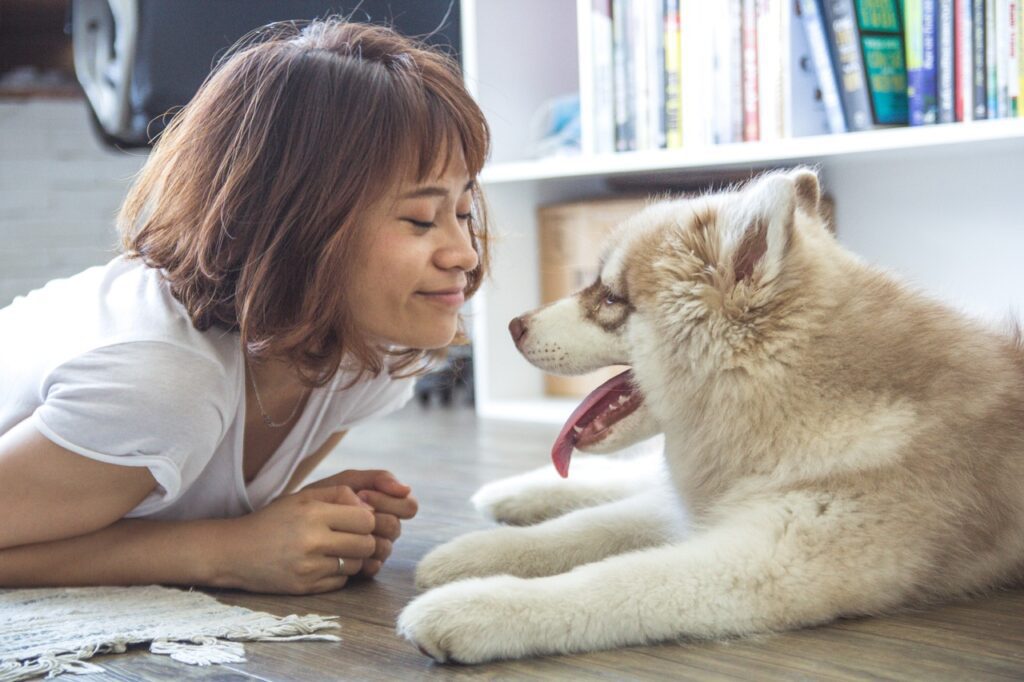🐾🎉 Woof Woof! Welcome to the pawsitively joyful world of understanding our furry best friends! Have you ever wondered if your tail-wagging companion can sense your happiness?
Well, grab a treat and get cozy, because we’re about to unleash the secrets behind your dog’s remarkable ability to know when you’re on cloud “k-nine! 🐶💖
Key Takeaway
| Key Takeaway | Summary |
|---|---|
| Do Dogs Know When You Are Happy? | Yes, dogs can sense our emotions through body language, facial expressions, and tone of voice. They often respond to our happiness by wagging their tails, being playful, or cuddling up to us. |
| Can Dogs Tell When You’re Smiling? | Dogs have an impressive ability to read human facial expressions, including smiles, and can differentiate between various human emotions just by looking at our faces. |
| Does My Dog Know I Love Him? | Dogs can sense affection and care through cues such as tone of voice, body language, and attention. They reciprocate love through their behavior, like wagging their tail, seeking attention, and being excited to see you. |
| Why Do Dogs Smile When You Talk To Them? | Dogs may “smile” due to mimicking human behavior, positive reinforcement, being relaxed and content, or displaying submissive behavior. Observe their overall body language to accurately interpret their emotions. |
| Do Dogs Know When You Are Not Happy With Them? | Dogs can sense when you are not happy with them by picking up on subtle cues like your tone of voice, body language, and facial expressions. They may react by displaying submissive behavior, avoiding eye contact, or trying to appease you. |
| Why Do Dogs Show Teeth When Happy? | Dogs may show teeth when happy due to a “submissive grin,” mimicking human behavior, or panting from excitement. Differentiate between a happy “smile” and a snarl by observing the dog’s overall body language. |
Do Dogs Know When You Are Happy?

Yes, dogs do know when you are happy! Our canine companions are highly skilled at picking up on our emotions, including happiness.
They can sense our emotions through various cues such as our body language, facial expressions, and tone of voice.
When we’re happy, dogs may notice our relaxed posture, smiling face, or cheerful tone, and they often respond by wagging their tails, being playful, or cuddling up to us.
This emotional understanding strengthens the bond between humans and dogs, making them the perfect companions for us.
Can Dogs Tell When You’re Smiling?

Yes, dogs can tell when you’re smiling! They have an impressive ability to read human facial expressions, including smiles.
Studies have shown that dogs can differentiate between various human emotions, such as happiness, sadness, and anger, just by looking at our faces.
When you smile, your dog is likely to recognize this as a sign of happiness, and it may respond by wagging its tail, being playful, or showing affection.
This remarkable skill further demonstrates the strong connection between humans and dogs.
Does My Dog Know I Love Him?
Yes. While dogs may not understand the concept of love in the same way humans do, they can certainly sense the affection and care you have for them.
Your dog picks up on various cues that indicate your love, such as your tone of voice, body language, and the attention you give them.
By spending quality time together, petting, playing, and providing for their needs, you create a strong bond with your dog, and they come to associate you with positive experiences and feelings of security.
Your dog’s behavior, such as wagging its tail, seeking your attention, and being excited to see you, can be signs that they recognize and reciprocate the love and care you give them.
So, while they might not understand the word “love,” they definitely feel the warmth and affection that comes with it.
Why Do Dogs Smile When You Talk To Them?
Dogs may appear to “smile” when you talk to them for several reasons, often related to their ability to pick up on your emotions and tone of voice.
Here are a few possible explanations:
- Mimicking human behavior: Dogs are experts at reading human facial expressions and body language. They may “smile” in response to your own smile or positive demeanor as a way of mimicking your behavior and connecting with you.
- Positive reinforcement: If you’ve previously rewarded your dog with praise, attention, or treats when they’ve displayed a “smiling” expression, they may be more likely to repeat this behavior in anticipation of rewards.
- Relaxed and content: A dog’s “smile” can also be a sign that they’re relaxed and content in your presence. When you talk to them in a soothing, friendly tone, they may respond with a “smile” to show their comfort and happiness.
- Submissive behavior: In some cases, a dog’s “smile” can be a sign of submission. If they sense that you’re in a good mood and non-threatening, they may display a “smile” along with other submissive behaviors to show their trust and respect.
It’s important to note that a dog’s “smile” may look different from a human smile, and it’s essential to observe their overall body language to accurately interpret their emotions.
Do Dogs Know When You Are Not Happy With Them?
Yes, dogs can often sense when you are not happy with them. They are highly perceptive of human emotions and can pick up on subtle cues such as your tone of voice, body language, and facial expressions.
If you express dissatisfaction, frustration, or anger, your dog is likely to notice these changes in your demeanor.
When dogs sense that you are unhappy with them, they may react in various ways, such as displaying submissive behavior, avoiding eye contact, or trying to appease you by wagging their tail low or licking their lips.
Some dogs might also become anxious or stressed, leading to behaviors like pacing, whining, or hiding.
It’s essential to be mindful of your emotions and communication when interacting with your dog, as they are sensitive to your feelings and may become stressed if they consistently sense negativity from you.
Positive reinforcement and clear, consistent communication are key to building a strong bond and maintaining a healthy relationship with your canine companion.
Why Do Dogs Show Teeth When Happy?
Dogs may show their teeth when they are happy due to a behavior known as a “submissive grin” or “smile.”
This expression is different from a snarl, which signals aggression or fear. Here are some reasons why dogs might show their teeth when they’re happy:
- Submission: A submissive grin is a way for dogs to communicate that they respect your authority and feel comfortable in your presence. They may show their teeth when they’re happy to signal that they don’t pose any threat.
- Mimicking human behavior: Dogs are highly perceptive of human emotions and facial expressions. They may show their teeth in response to your own smile, as they try to mimic your expression and connect with you.
- Panting: When dogs are happy and excited, they may pant more, which can cause their teeth to be more visible. This is not a deliberate display of teeth but rather a natural outcome of their increased breathing rate.
To differentiate between a happy “smile” and a snarl, pay attention to the dog’s overall body language.
A happy dog will have relaxed ears, a wagging tail, and a loose body posture, while an aggressive or fearful dog will have stiff body language, pinned-back ears, and possibly raised hackles.
In Conclusion
And there you have it, fellow dog lovers! As we’ve discovered, our beloved canine companions are not just experts at fetching balls and giving us endless cuddles, but they’re also incredibly in tune with our emotions, especially happiness.
So next time you share a moment of joy with your furry friend, remember that their wagging tail and excited eyes are a testament to the unbreakable bond you share. After all, happiness is best enjoyed with a loyal four-legged buddy by your side!





Leave a Reply